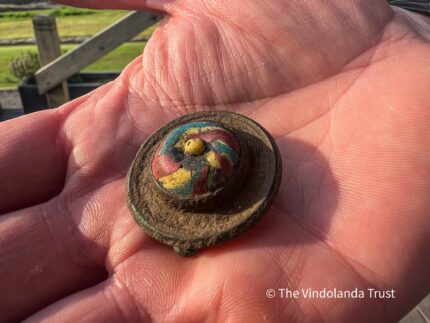A volunteer at this season’s excavation of the Roman auxiliary fort of Vindolanda just south of Hadrian’s Wall uncovered a brightly-colored disc brooch with catchplate, pin lugs and pin intact. The pin is still sharp and still fits neatly into its clasp. It dates to the late 3rd, early 4th century.
 The brooch is round with a low wall outlining a round central setting and a ridge around the outer edge. It is made of brass and would originally have been gilded. The molded glass inset mounted into the central setting is of the donut-shaped type: a flattened hemisphere with a dimple in the center topped by a small plug of glass that forms a nipple. It is multi-colored, with red, blue and yellow stripes swirling out from a yellow nipple.
The brooch is round with a low wall outlining a round central setting and a ridge around the outer edge. It is made of brass and would originally have been gilded. The molded glass inset mounted into the central setting is of the donut-shaped type: a flattened hemisphere with a dimple in the center topped by a small plug of glass that forms a nipple. It is multi-colored, with red, blue and yellow stripes swirling out from a yellow nipple.
Round brooches like this one have been found before, often with the glass inset missing. (The mounts on the round design appear to have been prone to loss; more insets have survived in the oval form.) They were of British manufacture and have been found almost entirely in Britain at varied sites (military, urban, religious, rural, etc.). Only about a dozen of the donut-shaped disc brooches are known in Britain, and of more than 600 oval and round brooches found, only 26 of them were discovered in archaeologically excavated and stratigraphically dated contexts.
The object is so beautiful and in such excellent condition, that even when it was freshly excavated it was clear that it was the stand-out find of the season. After it is cleaned and conserved, it will go on display at the Vindolanda museum.
See Marta Alberti-Dunn, Deputy Director of excavations, discuss the brooch with the volunteer who found it in this video: